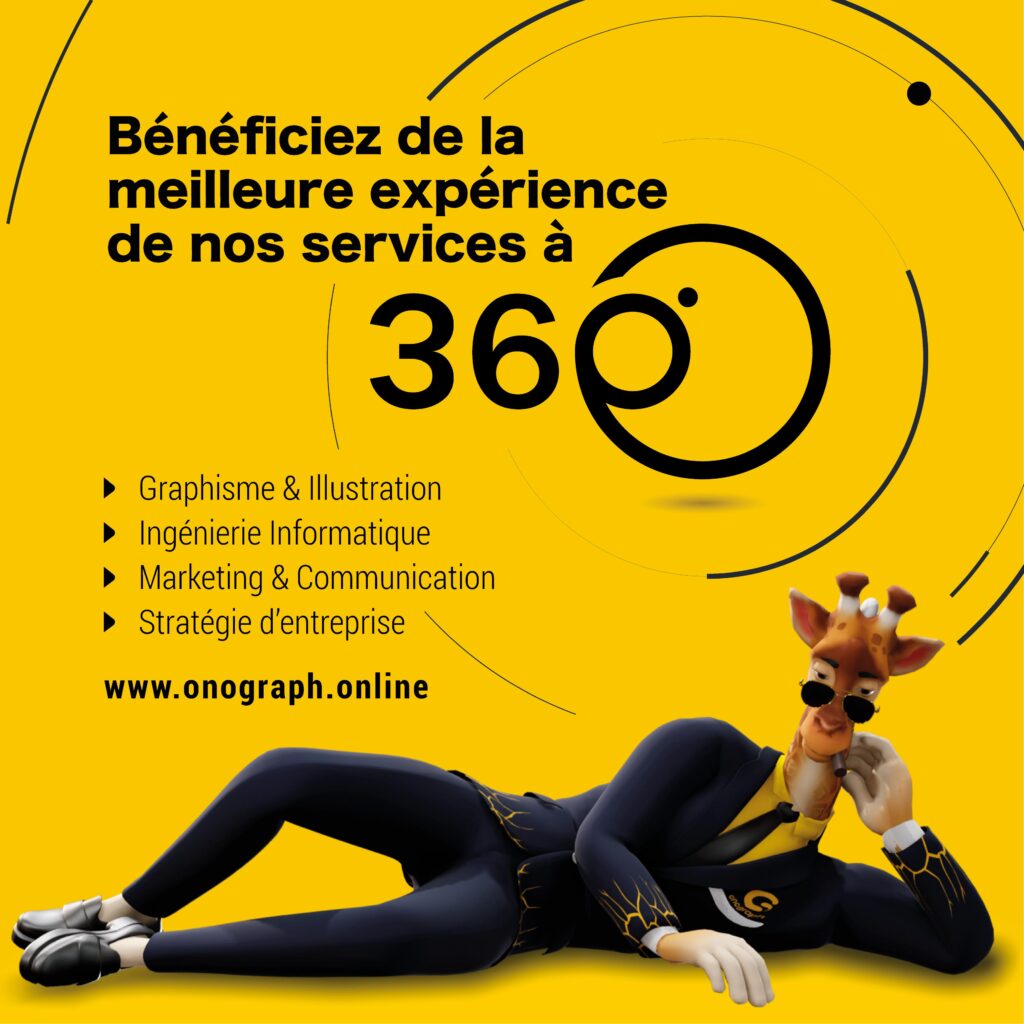Introduction In today’s digital ag...
(+ 237) 670 728 087 / 620 462 439
We combine our expertise in perfect synergy to create innovative, high-impact communication solutions tailored to your needs.
Want to know more? Our blog has all the answers.
Our articles are written by passionate professionals.
Introduction In today’s digital ag...

Advertising: an essential investment for...

Introduction In a constantly changing ec...
They have placed their trust in us
Graphic design and illustration play a crucial role in a company's visual communication. Here are some of the ways they are used and their importance:
Brand identification: Graphic design and illustration are used to create specific logos, colour palettes and typography that represent the company's visual identity. This helps to build brand recognition and market presence.
Visual communication: Images often have more impact than text alone. Graphics and illustrations are used in various communication media, such as websites, brochures, advertisements, presentations, etc., to effectively convey messages, ideas and concepts.
Competitive differentiation: Quality graphic design can help a company stand out from the competition by creating a memorable and attractive impression with its target audience.
Enhancing credibility: Professional graphics and well-designed illustrations enhance a company's credibility by giving the impression that it is professional and quality-conscious in all aspects of its operation.
Creating a positive user experience: In the digital world, a well-designed user interface and attractive illustrations contribute to a pleasant user experience, which can increase customer satisfaction and encourage engagement with the brand.
Education and explanation: Illustrations can be used to explain complex concepts in a visual and easily understandable way. This can be particularly useful in areas where clear communication is essential, such as education, health or technology.
Call to action: Well-placed graphic elements can direct the viewer's attention to important calls to action, such as signing up for a newsletter, buying a product or attending an event.
In short, graphics and illustration are powerful tools for a business, helping them to communicate effectively with their target audience, reinforce their brand and stand out from the competition.
Marketing and communication are two closely related fields that aim to promote and market products, services or ideas to a target audience. Here is an explanation of each:
Marketing: Marketing encompasses a set of activities and strategies aimed at identifying, anticipating and satisfying consumer needs while achieving a company's business objectives. Here are some of the key elements of marketing:
Market research: Marketing often begins with an in-depth analysis of the market, competitors and consumers to understand trends, preferences and buying behaviour.
Segmentation and targeting: Companies often segment their market into groups of consumers with similar characteristics, then target these segments with specific offers tailored to their needs and desires.
Positioning: Positioning involves determining how a brand wants to be perceived by its target audience in relation to its competitors. This often involves highlighting distinctive characteristics or competitive advantages.
Marketing mix (the 4Ps): The marketing mix is made up of the following four elements:
Product : The characteristics and advantages of the product or service.
Price: The pricing strategy.
Place: The distribution channels used to make the product available to the consumer.
Promotion: The tactics used to promote the product, such as advertising, promotional sales, content marketing, etc.
Analysis of results: Marketing often involves the collection and analysis of data to assess the effectiveness of strategies and campaigns, so that adjustments can be made if necessary.
Communication: Communication focuses on the effective transmission of the company's messages to its target audience. This can include various forms of communication, such as :
Advertising: Using paid media to disseminate promotional messages on a large scale.
Public relations: Creating and maintaining positive relationships with the media, influencers and the public in order to strengthen the company's reputation.
Digital marketing: Using online channels such as social networks, search engines, e-mail marketing, etc., to reach and engage target audiences.
Direct marketing: Direct communication with consumers through channels such as direct mail, telephone or SMS marketing.
Event marketing: Organisation of events to promote the brand, products or services and interact directly with the public.
Content marketing: Creating and distributing relevant and valuable content to attract, inform and retain potential customers.
In short, marketing and communication work together to achieve a company's business objectives by identifying market needs, developing appropriate offerings, and communicating effectively with the target audience to promote these offerings.
Computerising a business offers many benefits and can be essential for remaining competitive in a constantly changing business environment. Here are some of the reasons why it is important to computerise a business:
Improved operational efficiency: IT systems automate many repetitive and time-consuming tasks, allowing employees to concentrate on higher value-added activities. This can include stock management, order processing, invoicing, etc.
Increased productivity: Specialist software can streamline work processes and enable more effective collaboration between teams. Integrated communication tools, project management platforms and online collaboration software make it easier to coordinate efforts and take decisions.
Improved accuracy and reliability: IT systems reduce the risk of human error and ensure greater accuracy in business operations. This can help avoid data entry errors, delays in order processing and invoicing problems.
Better information management: Companies generate and manage a huge amount of information. IT systems enable this data to be stored, organised and analysed efficiently, making it easier to take informed decisions based on accurate, up-to-date information.
Improved customer satisfaction: IT systems enable faster, more personalised customer service. Customers can place orders online, track the status of their deliveries and obtain customer support more quickly, improving their overall experience with the company.
Adapting to technological change: In a world of rapidly evolving technology, businesses need to be able to adapt to stay competitive. Computerisation allows businesses to take advantage of the latest technological advances, such as artificial intelligence, data analysis and the Internet of Things (IoT).
Long-term cost savings: Although there may be initial costs associated with implementing IT systems, these can be offset by long-term savings. For example, automating processes can reduce labour requirements, and better resource management can minimise waste and inefficiencies.
In short, computerising a business offers many benefits, including greater operational efficiency, increased productivity, improved information management and improved customer satisfaction, while enabling the business to keep up with technological developments and reduce costs in the long term.
Indeed, auditing a company is a common and important practice for a number of reasons. Here are some of the main reasons why a company may choose to be audited:
Assessing financial health: A financial audit assesses a company's financial health by examining its financial statements, cash flows, assets and liabilities. This enables any errors, fraud or financial irregularities to be detected.
Regulatory compliance: Audits are often necessary to ensure that the company complies with current laws and regulations, both fiscal and legal. This may include compliance with accounting standards, labour laws, environmental regulations, etc.
Risk identification: The audit identifies the potential risks facing the company, whether financial, operational, legal or reputational. This enables the company to put in place measures to mitigate these risks and strengthen its internal processes.
Improving internal processes: By examining the company's internal practices and procedures, the audit can identify areas where improvements are needed to increase operational efficiency, reduce costs or strengthen internal controls.
Informed decision-making: The results of the audit provide valuable information to the company's management and stakeholders, enabling them to make informed decisions about the company's future direction, investments to be made, or adjustments to be made to existing strategies.
Increased stakeholder confidence: When the results of the audit show that the company is managed in a transparent and responsible manner, this strengthens the confidence of shareholders, investors, customers and other stakeholders in the company.
Contractual requirement: In some cases, particularly for listed companies or those with external business partners or funders, the audit may be a contractual requirement to ensure transparency and accountability.
In summary, the audit of a company is essential to assess its performance, compliance and risks, as well as providing crucial information for decision-making and building stakeholder confidence.
© 2024 Designed by Onograph
Subscribe and benefit from our promotional offers
RF8G+86X, Yaoundé, Cameroun (Simbock chapel before the nuns’ crossroads)
Email : info@onograph.online
Téléphone : + 237 670 728 087 / 620 117 453

Bonjour ! Que pourrions-nous faire pour vous ?